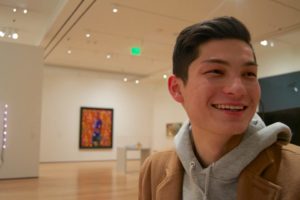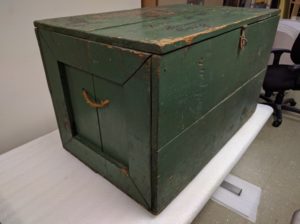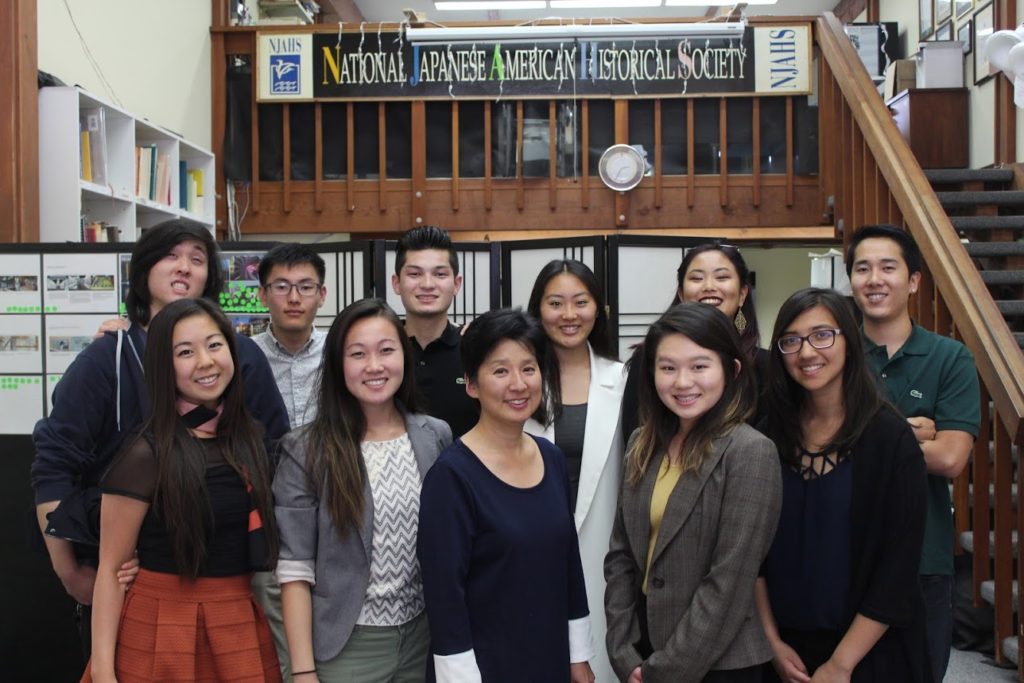I am Joseph Tsuboi, a multiracial yonsei from Moraga, California and rising junior at Tufts University in Medford, Massachusetts. I applied to the Nikkei Community Internship (NCI) hoping to broaden my sense community and to seek out fellow Nikkei undergraduates of the Bay Area. At the National Japanese American Historical Society (NJAHS), where I was placed, I have already learned an immense amount about this non-profit organization, San Francisco Japantown, and my own family history. Prior to this internship, I had little knowledge about the collection and preservation of artifacts or the production of exhibits. During my fall semester of my sophomore year at Tufts University, I took my first art history course with a leading scholar on the life and works of Frida Kahlo. Professor Adriana Zavala’s course allowed me to view art in relation to the artist’s life. Moreover, artists tell stories and are influenced by geopolitical forces of their time. Additionally, I am invested in Asian American Studies at Tufts University because I was not exposed to these rich, complex histories in the classroom and was not seeking them in the extracurricular activities of which I was a part. I was told fragments of my Japanese American family history, but have been attempting to extrapolate with concrete events and facts. Thus, my goals for this internship are to weave storytelling and Japanese American history together, while simultaneously uncovering how my Japanese American history is located in greater American history.
I have shadowed Max Nihei, Exhibits and Collections Manager, in scanning newspapers and photographs, cataloging items and writing their provenances, and inputting this information onto PastPerfect software. This process is technical and systematic, but is necessary to document items carefully and with detail. Most of these items are from Japanese American internship; they are decades old and represent a family’s wartime narrative. For example, a few weeks ago, NJAHS received a donation from the daughter of Mr. Harry Ichiro Nakamura, who was interned during World War II and also served in the Military Intelligence Service. Mr. Nakamura held onto a large, green wooden trunk in which he carried family items to and from WRA camps. On the trunk and on the canvas sheets inside were inscriptions of names of family members and addresses of camps and residential homes. Through final accountability records on Ancestry.com, I speculate that this green trunk likely traveled from Sacramento, California, to Tule Lake, to Amache, to Jerome, and then back to Sacramento in the hands of Mr. Nakamura’s sister, Ms. Masako Nakamura, after he was granted clearance at Amache. Overall, this green trunk represents many moments and movements of the Nakamura family.
This internship is an opportunity for me to explore my own Japanese American history. I have parsed through Ancestry.com for ship records, naturalization forms, and final accountabilities of family members whom I had little knowledge about. Before, I knew facts about my grandparents’ migration to the United States, but my knowledge stopped there. Notable finds include my family’s earliest migration – a 1902 travel record showing my great-grandfather, Hidekichi Tsuboi, on a ship from Yokohama, Japan to Honolulu. I strive to keep searching for similar finds and to create a mental timeline that extends as far back as possible. At Tufts, I hope to do an intensive project, perhaps an independent study, about my Japanese and Japanese American genealogy.
Overall, this internship in San Francisco Japantown is representative of both professional and personal interests. Currently at Tufts, I am declared an American Studies major and an Asian American Studies minor. I am now considering adding an Art History minor if I can complete this in the remaining two years of my undergraduate studies. In the long term, I intend to develop skills to work in a museum or educational setting that focuses on providing audiences full, accurate Asian American narratives. Additionally, this summer’s work presses me to think about and embrace my racial and ethnic identities. The Japanese American experience is nuanced and complexed, representing many generations and many people. I hope to walk away from this summer with greater pride for my yonsei, multiracial identity and with strong connections with community leaders and my fellow NCI interns. I believe that the Nikkei community extends beyond the physical boundaries of Japantowns; it is a community that pushes us youth to investigate our intersecting identities, our family histories, and our future involvement in Japanese American communities.






